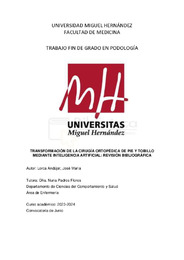Please use this identifier to cite or link to this item:
https://hdl.handle.net/11000/33316Full metadata record
| DC Field | Value | Language |
|---|---|---|
| dc.contributor.advisor | Padros Flores, Nuria | - |
| dc.contributor.author | Lorca Andújar, José María | - |
| dc.contributor.other | Departamentos de la UMH::Ciencias del Comportamiento y salud | es_ES |
| dc.date.accessioned | 2024-09-27T12:01:01Z | - |
| dc.date.available | 2024-09-27T12:01:01Z | - |
| dc.date.created | 2024-06-01 | - |
| dc.identifier.uri | https://hdl.handle.net/11000/33316 | - |
| dc.description.abstract | Introducción: La inteligencia artificial (IA) simula la inteligencia humana, permitiendo aprender y corregir errores, lo que es ideal para la cirugía ortopédica de tobillo y pie. Componentes clave como el aprendizaje automático (AA) y el aprendizaje profundo (AP) utilizan redes neuronales para tomar decisiones basadas en datos. ChatGPT, desarrollado por OpenAI, es capaz de analizar imágenes y textos complejos y, aunque aún es imperfecto, será esencial para la cirugía de pie y tobillo. Objetivo: Analizar cómo la IA ha transformado la cirugía ortopédica de pie y tobillo. Métodos: Se realizó una búsqueda bibliográfica en las bases de datos de Pubmed y Scopus, con información desde 2014 hasta la actualidad, incluyendo aquellos artículos que hablasen sobre la IA en la cirugía de pie y tobillo. Resultados: Se incluyeron seis artículos, de los cuales cuatro se obtuvieron a través de revisiones. Dos de ellos hablan sobre el ChatGPT y su versión mejorada ChatGPT4, otros dos sobre su aplicabilidad en el ámbito de la detección y pronóstico tras la operación de fracturas de tobillo, y los dos restantes sobre modelos exactos del pie y tobillo de los pacientes. Esto implica una mejora en la cirugía de pie y tobillo, favoreciendo la precisión de detección de la patología, la técnica quirúrgica y los resultados tras la operación. Conclusión: La IA está transformando la cirugía ortopédica de tobillo y pie, estableciendo bases esenciales para mejorar diagnósticos, procedimientos quirúrgicos y rehabilitación. | es_ES |
| dc.description.abstract | Introduction: Artificial intelligence (AI) simulates human intelligence, allowing it to learn and correct errors, which is ideal for orthopaedic ankle and foot surgery. Key components such as machine learning (ML) and deep learning (DL) use neural networks to make data-driven decisions. ChatGPT, developed by OpenAI, is capable of analysing complex images and text and, although still imperfect, will be essential for foot and ankle surgery. Objetive: To analyse how AI has transformed orthopaedic foot and ankle surgery. Methods: A literature search was conducted in the Pubmed and Scopus databases, with information from 2014 to the present, including articles discussing AI in foot and ankle surgery. Results: Six articles were included, four of which were obtained through reviews. Two of them are about ChatGPT and its improved version ChatGPT4, another two about its applicability in the field of detection and prognosis after ankle fracture surgery, and the remaining two about accurate models of the patients' foot and ankle. This implies an improvement in foot and ankle surgery, favouring the accuracy of pathology detection, surgical technique and post-operative outcomes. Conclusion: AI is transforming foot and ankle orthopaedic surgery, laying essential foundations for improved diagnostics, surgical procedures and rehabilitation. | es_ES |
| dc.format | application/pdf | es_ES |
| dc.format.extent | 36 | es_ES |
| dc.language.iso | spa | es_ES |
| dc.publisher | Universidad Miguel Hernández | es_ES |
| dc.rights | info:eu-repo/semantics/openAccess | es_ES |
| dc.rights | Attribution-NonCommercial-NoDerivatives 4.0 Internacional | * |
| dc.rights.uri | http://creativecommons.org/licenses/by-nc-nd/4.0/ | * |
| dc.subject | Inteligencia Artificial | es_ES |
| dc.subject | Cirugía | es_ES |
| dc.subject | Pie | es_ES |
| dc.subject | Tobillo | es_ES |
| dc.subject.other | CDU::6 - Ciencias aplicadas | es_ES |
| dc.title | Transformación de la cirugía ortopédica de pie y tobillo mediante inteligencia artificial: revisión bibliográfica | es_ES |
| dc.type | info:eu-repo/semantics/bachelorThesis | es_ES |

View/Open:
TFG JOSÉ MARÍA LORCA ANDÚJAR.pdf
1,34 MB
Adobe PDF
Share:
.png)
